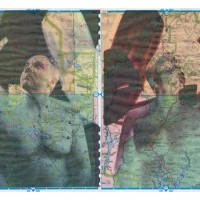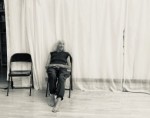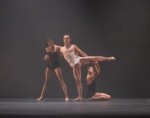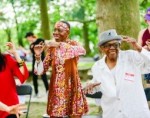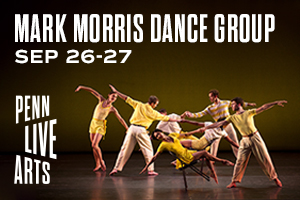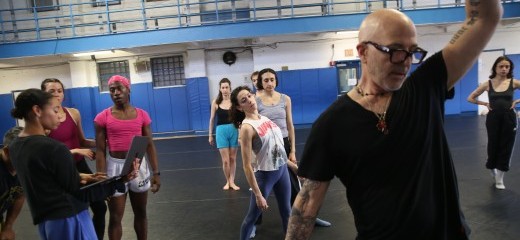
Approaching the End: Open Rehearsals with Stephen Petronio Company
by Brendan McCall
This February, the Stephen Petronio Company (SPC) announced that their July engagement at Jacob's Pillow would be their last. In the lead up to this final bow, the company held three open rehearsals in New York City, featuring a mix of excerpts that included some past works that will not appear in the Pillow program.
Stephen Petronio, founder and artistic director, has led SPC since 1984. “My dancers dove into the archives,” he said animatedly. “They decided which material they wanted to get into their amazing bodies.” With this choice to allow the dancers to choose how they embody history, Petronio has positioned himself as an important archivist and educator, as well as an influential artist.
1 May 2025
The dancers are stretching and warming up on a basketball court when I enter the rehearsal studio at the New York Center for Creativity and Dance. This building used to be a public school, I think. How appropriate, for such an athletic dance company. This stripped-down setting makes the space feel more vivid and immediate.
I sit in a folding metal chair just before Petronio steps forward to welcome us, casually introducing himself as “Stephen.” A minute in, he´s choking back tears, thanking Gino Grenek for his invaluable role in making these reconstructions happen. (Grenek danced for SPC from 1999-2007, then returned later as Petronio’s assistant). The atmosphere is already emotionally intense. This open rehearsal is both a celebration and a wake.
First up: a pair of duets from Bud Suite (2006). As dancers Larissa Asebedo and Jaqlin Medlock get into place, Stephen shares some brief context: “I was getting a little nervous about getting the music in time,” he says (Rufus Wainwright had agreed to compose an original score for what later became Bloom in 2007). “So I got to work, and used some tracks from Want One and Two. I liked how they fit together, he (Wainwright) let us keep them, so these dances just became their own thing.” A distinct homoerotic flavor permeates the choreography of both duets, especially the second featuring Deniz Sancack and Nicholas Sciscione. “Those two can´t keep their hands off each other, can they?” Stephen wryly remarks afterward. The audience chuckles with recognition.
Next comes American Landscapes (2019), a dance which evokes contrasting images of joy and conflict. The full company cuts and slices through the space, flexing their arms in gestures of temporary victory, before holding hands by the end in a long line that writhes forward and back. Our country, our community, I think, is convulsing into chaos.
This first day concludes with Yvonne Rainer's Chair Pillow (1969), part of SPC's Bloodlines project begun in 2014. "Yvonne's work really opened up the possibility to me that I could be a dancer and choreographer, even though I had no training,” Stephen said, before joining the rest of the full company on a chair, a pillow on his lap. Rainer's choreography is much simpler than Petronio's, and yet I can perceive connections between the two visions. Maybe it's the irreverence, I think, as I leave the studio, the hunger they both share to make something different and new.
29 May 2025
Before diving into the dances today, Stephen introduces each company member by name, expressing his profound appreciation for them during SPC's final rehearsal period. “These dancers are holding history within them,” he says.
After a reprise of the male duet from Bud Suite (this time performed by Isaiah Newby and Ryan Pliss), American Landscapes dances again–but with a twist. One dancer wraps herself in an American flag, while others wave flags celebrating Pride, bisexuality, and transness. This time, I note how frequently movement phrases begin with someone tripping or falling forward. Perhaps Petronio is implicating today’s America, I wonder. Maybe it's all the result of repeated, accumulated accidents.
Strange Attractors Part I (1999), a lesser-known work, opens with a gorgeous solo by Sancak, followed by a duet by the talented Asebedo and Sciscione. “This piece was a crucial part of my development as a choreographer,” Petronio tells us. He goes on to say he grew interested in shifting away from the “tough, blunt, hard-edged” movement vocabulary that characterized his work up to that point, seeking more length and extension in the body instead. Sancak certainly embodies that principle. I watch his long limbs move at the speed of controlled chaos, and his spine ripples in complex fractal patterns.
In Underland (2003), Medlock's arms and torso conjure strange sequences of detailed body articulations, a living sculpture animated by a solo piano score by Nick Cave. “When I made this,” Stephen explains, “I was in this tiny little room, and could only see my upper body in the mirror.”
Stephen introduces City of Twist (2002), SPC's first work post-9/11, as his “love letter to my city.” He sketched out a series of fictional characters for this collection of solos, which in turn inspired Laurie Anderson to compose the score. “I went to her studio, and there's this small woman with spikey hair and surrounded by banks of computers,” he says with a grin. I smile, too, totally picturing the scene.
Liviya England performs the first solo, her character a “broken down vaudeville dancer,” according to Petronio. A soft sorrow infuses her gestures, her limbs seduce me with their gentility and effortlessness. By contrast, Taylor Massa’s solo is more “punky”: rapid, attacking gestures interspersed with brief interludes of suspension. Her energy radiates fear and outrage. She keeps holding her stomach, yet always finds the strength to continue.
26 June 2025
“Pop songs are often a golden key for my more abstract work,” Petronio says, introducing Ride the Beast (2007). Thom Yorke´s crooning vocals create a melancholic atmosphere for the trio (Asebedo, England, and Pliss) to inhabit, their limbs extending into space with liquid precision. After they finish, even Stephen seems moved. “I look at them,” he says, “and I still don't know how they did it.”
Petronio originally choreographed Broken Man (2002) for himself after breaking his foot, not knowing if he would be able to dance again. Today, dancer Tess Montoya easily settles into the solo's vulnerability. Often with a hand to the heart, her hands and feet evoke sadness, grace, and restraint. As the tempo grows more energetic and complex, her body (and through her, Stephen’s) seems to heal before our eyes.
“A lot of my work is uncoordinated,” Stephen says at the top of The Island of Misfit Toys (2003), a statement that keeps circling through my mind during the dance. Medlock and Pliss leap like elves to a haunting cello score by Lou Reed. Their bodies do everything briefly: they flutter, they poke, and they jab, keeping each other off-balance with playful mischief. This duet is the complete opposite of Like Lazarus Did (2013), a solo showcasing Sciscione. He slithers across the floor like an eel, then spirals and rolls over his torso with his limbs pressed together. How beautifully jarring, I think, when he finally stands up on his feet at the end.
Introducing Full Half Wrong (1992), SPC’s reinterpretation of Stravinsky, Petronio explains that he was “raised by feminist wolves, so I always found it odd that in the story a virgin needs to be sacrificed so we can eat food.” Asebedo gives a riveting rendition of the opening solo. She points her fingers towards her pelvis, then executes swift gestures of power and defiance. In this telling, her virginity is the source of spiritual and sexual strength; she kicks and lashes out with her whole body, battling unseen forces.
The full company gets into place for MiddleSexGorge (1990). “This piece was inspired by my experience in ACT UP during the AIDS epidemic,” Petronio says. “One day I got arrested, and after the cops released me, I went right to rehearsal. I thought, if I can't make something meaningful, then I should just stop.”
An homage to power and control, MiddleSexGorge is also about consent. Frequently aggressive and set to music by the British post-punk band Wire, the dance creates an atmosphere that is dark, muscular, and sexy. “This is when I really started moving the pelvis forward in my choreography,” Stephen admits. This pace is relentless and driving. Intricate partnering moments shift into unison trios, before fragmenting into groups of five. The technical speed and precision are dizzying, so when the ensemble eventually stops, the thunderous applause is cathartic.
“I am so proud of them,” Stephen says, joining his dancers for their last bow in New York. His voice cracks again, holding in the emotion. I can't imagine what he must be feeling at this moment. "Don't forget us when this is over,” he tells us, wiping a tear from his eye.
Stephen Petronio Company, three open rehearsals at the New York Center for Creativity and Dance, May 1st and 29th, and June 26th.
Homepage Image Description: A line of eleven people are holding hands in front of bright large windows, their legs lunging and their heads turned in different directions. They were sweat pants and t-shirts, shorts or tank tops, all of various colors. Some of them are looking to their right and down, others looking up and left.
Article Page Image Description: In the foreground, a white man with a black t-shirt with tattoos on his forearms and wearing thick glasses has his left arm raised, demonstrating some kind of movement. Behind him, a group of men and women in sweatpants and t-shirts listen in various ways: some are imitating his movements, while others are standing in place. To the left, a Black woman is looking at a laptop.
By Brendan McCall
July 22, 2025

